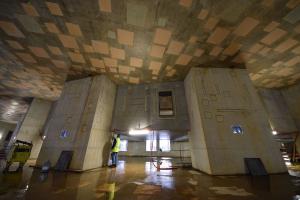In the tokamak's subterranean world
24 Oct 2016
It's a world that evokes underground quarries, a cathedral carved out of rock, a pyramid's secret chamber... The space between the lower basement slab (B2) and the next-level slab (B1) of the Tokamak Complex is punctuated by 18 giant columns that will rise 30 metres when completed and provide structural support to the Tokamak Building.
In this cavernous space, thousands of embedded plates stud the ceiling, floor and walls like geometric constellations—these will be used to anchor the equipment that must be installed at every level of the building.
The thick walls between the massive columns will house pipe chases, and are made of extra-dense concrete that is formulated with magnetite gravel sourced in Swedish Lapland.
The only sunlight that enters this subterranean realm comes from regular double openings in the bioshield wall, reserved for the magnet feeders that will relay electrical power and cryogens to the ITER magnets.
What is today a vast open space around the Tokamak assembly arena will one day be occupied by the dense piping of the cooling water system primary circuit. Gone will be the cathedral-like space ... replaced by a forest of steel pipes and pumps.


